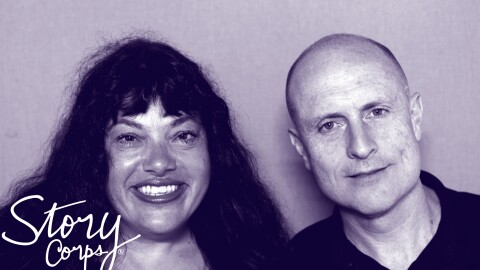John Cross didn’t think he was military material after a childhood battle with polio left him with a weakened upper body. But a dire need for soldiers led him to enlist in the National Guard.
John was one of the soldiers ordered to patrol Ohio State and control students protests against the Vietnam War and racial inequality in 1970. When the StoryCorps booth visited Columbus, John sat down with his daughter, Elizabeth Cross, to recount his enlistment and the campus riots that spring.
John grew up in the ‘40s, which he calls a magical era “without video games or television.” He was born in Florida, but returned with his family to Delaware, Ohio, to be closer to relatives when his father fought in World War II.
As a toddler, John fell ill with polio, but luckily recovered and had an active childhood of fishing and sledding.
Despite his parents’ worries that his brush with polio would make him unfit to serve, he enlisted in the National Guard. One particular memory Elizabeth asked about involved student riots that happened on Ohio State’s campus.
“At the beginning of the whole riot, your mother was in class,” John recalls. “She saw it start.”
The riots, according to John’s wife, began when students barricaded a gate along a campus avenue and refused to budge. Police were called to the scene and showered the students involved with a haze of tear gas.
“That’s how it really started and escalated,” John says. He arrived on the scene with another officer and spent the whole night trying to control the situation.
According to the Ohio State library, the "spring of dissent" was triggered by several factors, including a lack of support and services for African American and women students, and a dearth of student representation in the university's decisionmaking.

After a restless night, Ohio State leadership called the troops in for backup at the administration building, which the university president and other administrators worried students might overtake. By this point, everyone in the community knew about the protests.
“I can remember sitting at home, and mom would sneak into the bedroom to listen to the radio because she would be afraid that something would happen to you at those riots,” Elizabeth said.
John explains that while emotions ran high among students and soldiers, it all felt under control. That didn’t mean that containing the protests was easy, he said. Throngs of students gathered to observe the commotion during passing periods, and when the group grew and wouldn’t disband, the troops reacted.
“We shot tear gas, moved them back,” John says.
The administration building, Bricker Hall, sits next to a large open grass walkway called The Oval, which made it difficult to disband the students.
“You can’t do that when you have a huge oval!” he said.

The soldiers pushed students to High Street, but the city of Columbus complained they needed to be moved back to campus.
“We finally moved back and they set up some sort of speaking platform [for the protesters],” John says.
At this point, John remembers that one troop went up to the students and said, “We are here, you can do what you want, we’re not trying to stop you.” John says that calmed things down. “Everything worked out,” he said.
John and his fellow company soldiers remained stationed at Ohio State a full week, before campus stabilized and they were allowed to return home.
The Sunday they left Ohio State, John received a call from the battalion commander, asking if his troops could go up and handle a situation at Kent State. “And so I’m looking at my troops cleaning their weapons and I said, ‘No, they’re all going home,’” John says.
John believes that if his troops had gone to Kent State, “no one would have been shot” in the fatal riot that left four students dead and nine wounded. John believes his unit had greater experience from deescalating the riots at Ohio State and could have helped.
After the Kent State shooting, the campus activism quieted. Ohio State canceled classes and cleared campus for two weeks that May. “We didn’t go on any active duty after that,” John says.
John and Elizabeth Cross were recorded in the StoryCorps booth during its recent trip to Columbus.
To hear more stories from your neighbors, be sure to subscribe to the StoryCorps COLUMBUS podcast on Apple, Spotify, Stitcher, or wherever you get your podcasts.






